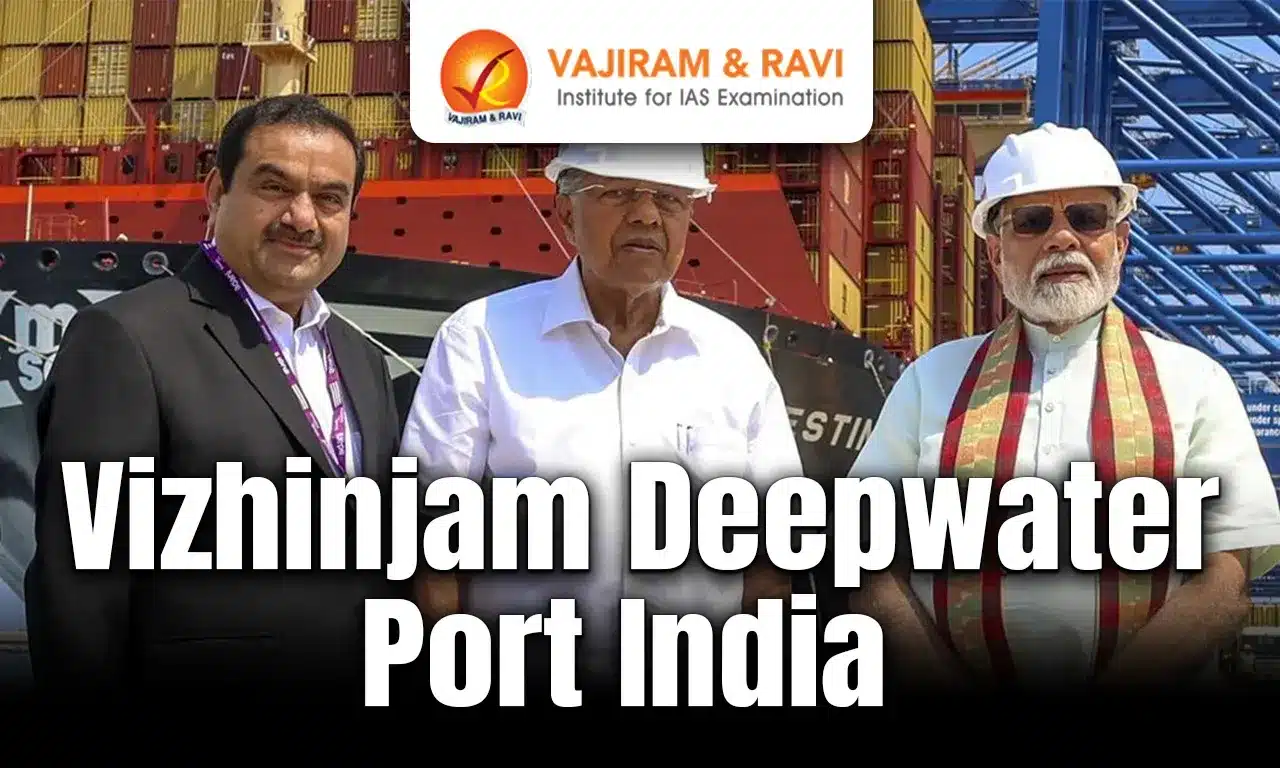What’s in Today’s Article?
- Vizhinjam Port Latest News
- Introduction
- About Vizhinjam Deepwater Port
- Key Features and Strategic Importance
- Economic Impact and Cost Savings
- Vision for a Port-led Economy
- Wider Maritime and Industrial Push
- Conclusion
- Vizhinjam Port FAQs
Vizhinjam Port Latest News
- Prime Minister Narendra Modi commissioned the ₹8,800 crore Vizhinjam International Deepwater Multipurpose Seaport in Kerala’s capital.
Introduction
- India has officially entered the global container transhipment league with the inauguration of the Vizhinjam International Deepwater Multipurpose Seaport in Kerala.
- Commissioned by Prime Minister Narendra Modi on May 2, 2025, the ₹8,800 crore project marks the culmination of decades-long efforts to establish India’s first deepwater transhipment port, positioned strategically to serve as a vital logistics hub in the Indian Ocean region.
About Vizhinjam Deepwater Port
- The Vizhinjam Port, located near Thiruvananthapuram in Kerala, has been developed under a Public-Private Partnership (PPP) model between the Adani Group and the Kerala government.
- With a natural draft of nearly 20 metres, it can accommodate ultra-large container vessels, a key requirement for global cargo movement.
- The port had been conceptualized as far back as 1991, but saw several delays due to environmental, legal, and logistical challenges. Its eventual operationalization in 2025 marks a major milestone in India’s maritime infrastructure ambitions.
Key Features and Strategic Importance
- Natural Depth & Strategic Location: The port’s depth and proximity to international shipping lanes make it ideal for large cargo vessels with over 20,000 container capacity.
- Low Maintenance Advantage: Minimal coastal sand movement around the port ensures reduced dredging and maintenance costs.
- Reduced Dependency on Foreign Ports: Vizhinjam aims to significantly reduce India’s reliance on transhipment hubs like Colombo, Singapore, and Jebel Ali, which currently handle 75% of India’s transhipped cargo.
Economic Impact and Cost Savings
- According to government estimates, India will save approximately $220 million annually by managing its own transhipment cargo. Presently, the country pays an additional $80–$100 per container due to reliance on foreign ports. Bringing these operations in-house will:
- Improve logistics efficiency
- Reduce delivery delays
- Strengthen India’s economic resilience during geopolitical disruptions
- This move is expected to transform the shipping landscape in the country by retaining foreign exchange and increasing internal job opportunities within the port and logistics sectors.
Vision for a Port-led Economy
- In his address, Prime Minister Modi emphasized that port cities and coastal states will play a critical role in realizing the vision of a developed India.
- He noted that the government’s maritime policy over the last decade has focused on integrating modern infrastructure with ease of doing business. Over the last ten years, billions have been invested through PPP models to modernize Indian ports and bring them on par with global standards.
- The Vizhinjam port also serves as a model of cooperative federalism, with a Left-led state government partnering with a major private enterprise, Adani Ports and SEZ Ltd, to realize a shared economic vision.
Wider Maritime and Industrial Push
- The inauguration of the Vizhinjam Port aligns with broader national strategies:
- Shipbuilding Promotion: The Union Budget has introduced policies to promote indigenous ship construction.
- Kochi Shipbuilding Cluster: A shipbuilding and repair hub is being developed in Kochi to enhance employment and manufacturing in the sector.
- Improved Global Rankings: India now has two ports in the world’s top 30 and ranks among the top 20 in the Logistics Performance Index.
Conclusion
- The Vizhinjam International Deepwater Port is not just a logistical upgrade; it is a strategic economic pivot.
- By reducing external dependencies, optimizing maritime routes, and creating local employment, the port symbolizes India’s growing stature in global trade.
- As its capacity expands in the coming years, it is expected to become a cornerstone of India’s maritime policy and a major economic engine in the Indo-Pacific region.
Vizhinjam Port FAQs
Q1. What is the Vizhinjam Port?
Ans. It is India’s first dedicated deepwater container transshipment port located in Kerala.
Q2. How much has been invested in the Vizhinjam Port project?
Ans. The port has been built at an estimated cost of ₹8,800 crore under a public-private partnership.
Q3. What are the economic benefits of the Vizhinjam Port?
Ans. It is expected to save India $220 million annually by reducing reliance on foreign transshipment hubs.
Q4. Which companies and governments are involved in the project?
Ans. The port is operated by Adani Ports in partnership with the Kerala government.
Q5. How will Vizhinjam Port impact global trade for India?
Ans. It will allow India to directly handle large cargo ships, improve logistics, and boost trade efficiency.
Last updated on November, 2025
→ Check out the latest UPSC Syllabus 2026 here.
→ Join Vajiram & Ravi’s Interview Guidance Programme for expert help to crack your final UPSC stage.
→ UPSC Mains Result 2025 is now out.
→ UPSC Notification 2026 is scheduled to be released on January 14, 2026.
→ UPSC Calendar 2026 is released on 15th May, 2025.
→ The UPSC Vacancy 2025 were released 1129, out of which 979 were for UPSC CSE and remaining 150 are for UPSC IFoS.
→ UPSC Prelims 2026 will be conducted on 24th May, 2026 & UPSC Mains 2026 will be conducted on 21st August 2026.
→ The UPSC Selection Process is of 3 stages-Prelims, Mains and Interview.
→ UPSC Result 2024 is released with latest UPSC Marksheet 2024. Check Now!
→ UPSC Prelims Result 2025 is out now for the CSE held on 25 May 2025.
→ UPSC Toppers List 2024 is released now. Shakti Dubey is UPSC AIR 1 2024 Topper.
→ UPSC Prelims Question Paper 2025 and Unofficial Prelims Answer Key 2025 are available now.
→ UPSC Mains Question Paper 2025 is out for Essay, GS 1, 2, 3 & GS 4.
→ UPSC Mains Indian Language Question Paper 2025 is now out.
→ UPSC Mains Optional Question Paper 2025 is now out.
→ Also check Best IAS Coaching in Delhi

















